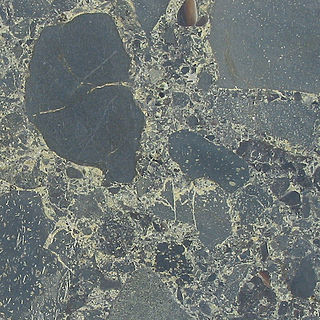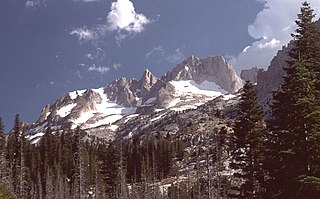
An intrusive suite is a group of plutons related in time and space. [1] All rocks in an intrusive suite result from the same magma-producing event. [2]

An intrusive suite is a group of plutons related in time and space. [1] All rocks in an intrusive suite result from the same magma-producing event. [2]

The Colorado Mineral Belt (CMB) is an area of ore deposits from the La Plata Mountains in Southwestern Colorado to near the middle of the state at Boulder, Colorado and from which over 25 million troy ounces of gold were extracted beginning in 1858. The belt is a "northeast-striking zone defined by: a Proterozoic shear zone system ; a suite of Laramide-aged plutons and related ore deposits ; a major gravity low ; low-crustal velocities; and high heat flow ." Mining districts include:

Breccia is a rock composed of large angular broken fragments of minerals or rocks cemented together by a fine-grained matrix.

Cathedral Peak is part of the Cathedral Range, a mountain range in the south-central portion of Yosemite National Park in eastern Mariposa and Tuolumne Counties. The range is an offshoot of the Sierra Nevada. The peak which lends its name to the range derives its name from its cathedral-shaped peak, which was formed by glacial activity: the peak remained uneroded above the glaciers in the Pleistocene.

Intrusive rock is formed when magma penetrates existing rock, crystallizes, and solidifies underground to form intrusions, such as batholiths, dikes, sills, laccoliths, and volcanic necks.

The Musgrave Block is an east-west trending belt of Proterozoic granulite-gneiss basement rocks approximately 500 kilometres (310 mi) long. The Musgrave Block extends from western South Australia into Western Australia.

The Barberton Greenstone Belt is situated on the eastern edge of the Kaapvaal Craton in South Africa. It is known for its gold mineralisation and for its komatiites, an unusual type of ultramafic volcanic rock named after the Komati River that flows through the belt. Some of the oldest exposed rocks on Earth are located in the Barberton Greenstone Belt of the Eswatini–Barberton areas and these contain some of the oldest traces of life on Earth, second only to the Isua Greenstone Belt of Western Greenland. The Makhonjwa Mountains make up 40% of the Baberton belt. It is named after the town Barberton, Mpumalanga.

In geology, an igneous intrusion is a body of intrusive igneous rock that forms by crystallization of magma slowly cooling below the surface of the Earth. Intrusions have a wide variety of forms and compositions, illustrated by examples like the Palisades Sill of New York and New Jersey; the Henry Mountains of Utah; the Bushveld Igneous Complex of South Africa; Shiprock in New Mexico; the Ardnamurchan intrusion in Scotland; and the Sierra Nevada Batholith of California.

The Sierra Nevada Batholith is a large batholith which forms the core of the Sierra Nevada mountain range in California, exposed at the surface as granite.

The Cathedral Peak Granodiorite (CPG) was named after its type locality, Cathedral Peak in Yosemite National Park, California. The granodiorite forms part of the Tuolumne Intrusive Suite, one of the four major intrusive suites within the Sierra Nevada. It has been assigned radiometric ages between 88 and 87 million years and therefore reached its cooling stage in the Coniacian.

The Vishnu Basement Rocks is the name recommended for all Early Proterozoic crystalline rocks exposed in the Grand Canyon region. They form the crystalline basement rocks that underlie the Bass Limestone of the Unkar Group of the Grand Canyon Supergroup and the Tapeats Sandstone of the Tonto Group. These basement rocks have also been called either the Vishnu Complex or Vishnu Metamorphic Complex. These Early Proterozoic crystalline rocks consist of metamorphic rocks that are collectively known as the Granite Gorge Metamorphic Suite; sections of the Vishnu Basement Rocks contain Early Paleoproterozoic granite, granitic pegmatite, aplite, and granodiorite that have intruded these metamorphic rocks, and also, intrusive Early Paleoproterozoic ultramafic rocks.

Half Dome Granodiorite is granodiorite found in a region on and near Half Dome, in Yosemite National Park, California, United States. The granodiorite forms part of the Tuolumne Intrusive Suite, one of the four major intrusive suites within the Sierra Nevada.

El Capitan Granite is a type of granite, in a large area near El Capitan, in Yosemite National Park, California, United States. The granite forms part of the Tuolumne Intrusive Suite, one of the four major intrusive suites within the Sierra Nevada.
Kuna Crest Granodiorite, is found, in Yosemite National Park, United States. The granodiorite forms part of the Tuolumne Intrusive Suite, one of the four major intrusive suites within the Sierra Nevada. Of the Tuolumne Intrusive Suite, it is the oldest and darkest rock.
Sentinel granodiorite is a type of granodiorite found in Yosemite National Park. It is a poorly understood western "outlier" of the ~93-85-Ma Tuolumne Intrusive Suite of the Sierra Nevada batholith. It is only slightly older than the undated Yosemite Creek Granodiorite and the Kuna Crest Granodiorite.

The Tuolumne Intrusive Suite is one of several intrusive suites in Yosemite National Park. These also include

The Fine Gold Intrusive Suite is one of several intrusive suites that crosses into Yosemite National Park. These also include

The Intrusive Suite of Buena Vista Crest is an intrusive suite which extends 30 kilometres (19 mi) southward, from Yosemite Valley to Yosemite National Park's southeastern boundary, into plutons of the Sierra Nevada Batholith, which are slightly older. These intrusive suites also include

The Intrusive Suite of Yosemite Valley is one of several intrusive suites in Yosemite National Park. These also include

The Intrusive Suite of Sonora Pass is one of several intrusive suites in Yosemite National Park. These also include

The Intrusive Suite of Merced Peak is one of several intrusive suites in Yosemite National Park. These also include: